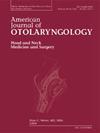Outcomes with transcutaneous bone conduction implants in patients with mixed hearing loss
IF 1.7
4区 医学
Q2 OTORHINOLARYNGOLOGY
引用次数: 0
Abstract
Objective
To evaluate audiological outcomes of transcutaneous devices among individuals with mixed hearing loss (MHL) who underwent implantation with the Cochlear™ Osia® and Med-El Bonebridge™ devices.
Methods
Adults with MHL in at least one ear, including a best bone conduction (BBC) threshold of 30 dB HL or poorer, and air-bone gaps of 15 dB HL or more at one or more frequencies were implanted with the Cochlear™ Osia® or Med-El Bonebridge™ devices for MHL. Four-frequency pure tone average (PTA) was calculated for aided thresholds and compared to preoperative PTAs for BBC thresholds.
Results
Among the study participants, 11 were implanted with Osia, and 11 were implanted with Bonebridge. In the Osia group, the BBC PTA averaged 23.6 dB, which was not significantly different from the aided PTA of 27.0 dB (P = 0.2). In the Bonebridge group, the BBC PTA averaged 23.3 dB while the aided PTA was significantly poorer at 32.9 dB (P = 0.03). In both groups, aided sound field thresholds were worse than BBC thresholds overall except for a 7 dB improvement at 2000 Hz in the Osia group (P < 0.05).
Conclusion
We highlight important limitations of current transcutaneous bone conduction systems for rehabilitation of MHL. Sound field outcomes for Osia and Bonebridge devices are limited by the BBC thresholds of either ear; these devices do not provide significant gain or “overclosure” beyond BBC thresholds. While both groups generally experienced declines in aided thresholds compared to best conduction thresholds, the Osia implant exhibited an exception of a 7 dB improvement at 2000 Hz.
混合性听力损失患者经皮骨传导植入体的疗效。
目的:评估经皮设备对混合性听力损失(MHL)患者的听力效果:评估科利耳™ Osia® 和 Med-El Bonebridge™ 经皮设备对混合性听力损失(MHL)患者的听力效果:成年患者至少有一只耳朵患有 MHL,包括最佳骨传导(BBC)阈值为 30 dB HL 或更低,且在一个或多个频率上的气骨间隙为 15 dB HL 或更高,他们都植入了科利耳™ Osia® 或 Med-El Bonebridge™ 设备来治疗 MHL。计算了辅助阈值的四频纯音平均值(PTA),并与 BBC 阈值的术前 PTA 进行了比较:研究参与者中,11 人植入了 Osia,11 人植入了 Bonebridge。在 Osia 组,BBC PTA 平均值为 23.6 dB,与辅助 PTA 27.0 dB 相比差异不大(P = 0.2)。在 Bonebridge 组,BBC PTA 平均为 23.3 分贝,而辅助 PTA 则明显较差,为 32.9 分贝(P = 0.03)。在这两组中,除了 Osia 组在 2000 Hz 时提高了 7 dB 之外,辅助声场阈值总体上都比 BBC 的阈值差(P 结论:Bonebridge 和 Osia 组的辅助声场阈值都比 BBC 的阈值差):我们强调了目前经皮骨传导系统在多发性硬化症康复方面的重要局限性。Osia 和 Bonebridge 设备的声场效果受限于任一耳朵的 BBC 阈值;这些设备不能在 BBC 阈值之外提供显著的增益或 "过度封闭"。虽然与最佳传导阈值相比,两组患者的辅助阈值都普遍下降,但 Osia 植入体在 2000 Hz 时的改善幅度达到了 7 dB。
本文章由计算机程序翻译,如有差异,请以英文原文为准。
求助全文
约1分钟内获得全文
求助全文
来源期刊

American Journal of Otolaryngology
医学-耳鼻喉科学
CiteScore
4.40
自引率
4.00%
发文量
378
审稿时长
41 days
期刊介绍:
Be fully informed about developments in otology, neurotology, audiology, rhinology, allergy, laryngology, speech science, bronchoesophagology, facial plastic surgery, and head and neck surgery. Featured sections include original contributions, grand rounds, current reviews, case reports and socioeconomics.
 求助内容:
求助内容: 应助结果提醒方式:
应助结果提醒方式:


